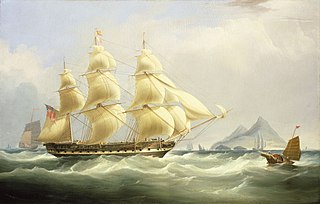Related Research Articles
Many vessels have been named Minerva for the mythological figure Minerva:
A number of sailing ships have been named Ocean.
A number of vessels have been named Alexander:
A number of ships have been named Asia, including:
Numerous ships with the name Phoenix, for the constellation or the mythical bird, have sailed for the British East India Company (EIC) between 1680 and 1821:
Albion was a sailing ship of two decks and three masts, built at Bristol, England, and launched in 1813. She made three voyages transporting convicts to Van Diemen's Land and New South Wales. She also traded with Jamaica, India, and Quebec. For two of the voyages to India she was an "extra" ship to the British East India Company (EIC).

A number of ships with the name Asia served the British East India Company (EIC) as East Indiamen:
Numerous British vessels that have served the British East India Company (EIC) have borne the name Prince of Wales, after the then current Prince of Wales, the title borne by the heir-presumptive to the throne of the United Kingdom.

A number of sailing ships have been named Eliza.
Numerous vessels have borne the name Fame:

Minerva was launched at Lancaster, Lancashire, in 1805. Following trading with Central and South America, she made two voyages under charter to the British East India Company (EIC) between 1811 and 1814. She also made four voyages transporting convicts to Australia between 1818 and 1824, one to Van Diemen's Land and three voyages to New South Wales. She was broken up in 1826.
Several ships have borne the name Caledonia for Caledonia:

Fairlie was launched at Calcutta in 1810 and sailed to England. There she became a regular ship for the British East India Company (EIC). Including her voyage to England, she made four voyages for the EIC. From around 1821 on she became a Free Trader, continuing to trade with India under a license from the EIC. She also made two voyages transporting convicts to New South Wales (1834), and Tasmania (1852). She made several voyages carrying immigrants to South Australia, New South Wales, and British Guiana. Fairlie foundered in November 1865.
Several vessels have been named Prince George:
Several vessels have been named Nile either for the Battle of the Nile, or for the Nile river:
Several vessels have been named Princess Charlotte for one of the many Princesses Charlotte:
Several vessels have been named Mary Ann:
Several vessels have been named Glory:
Several vessels have been named Prince Regent for George IV, of England, who was Prince regent from 1811 to his accession to the throne in 1826:
References
- Hackman, Rowan (2001). Ships of the East India Company. Gravesend, Kent: World Ship Society. ISBN 0-905617-96-7.